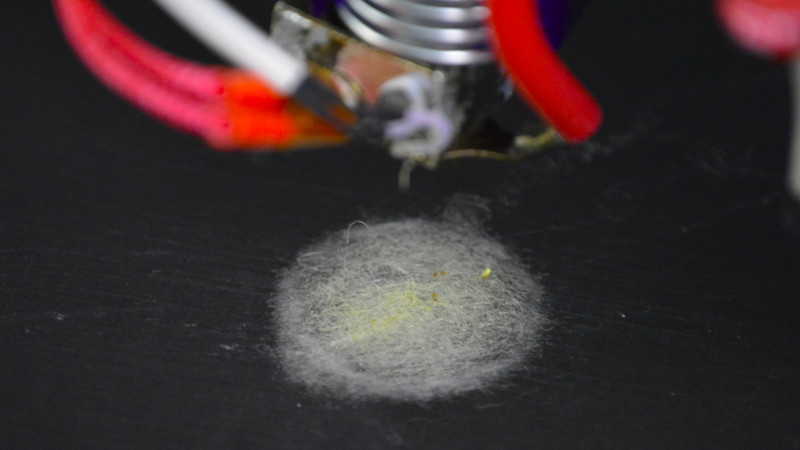We are all used to desktop 3D printers that extrude molten plastic in layers to build up finished items. A pair of researchers at the Human-Computer Interaction Institute at Carnegie Mellon University, [Michael Rivera] and [Scott Hudson], have added another capability to their printer: electrospinning of textiles.
Electrospinning is a technique in which an extruded material is accelerated from the extruder by an electrostatic charge to form an extremely thin fibre. By applying a many-kilovolt charge between the extruder and the bed, they can create a fibre and lay it down into a mesh from a height to create a felt-like fabric. The same extruder can also produce conventional solid prints, allowing the creation of composite fabric and solid items. They demonstrate a variety of prints including a folding mobile phone stand, a woven lamp, and an interactive wooly sheep, which along with others can be seen in the video below the break.
The full paper can be downloaded as a PDF, and makes for very interesting reading. The voltages involved mean that your Prusa clone may not have this capability any time soon, but we look forward to the moment when desktop electrospinning is a feature on affordable 3D printers.
















I am pleased to see this research into electrospinning, I have long felt that this would be ideal for assistive technology.
“felt”?? pun intended? :-)
It seems that it is limited to electro-spinning directly to the build-plate only. Potential does exist for using a conductive FDM print as a scaffold.
>potential
hhhehehe
I’ve seen several articles here about electospinning, but I don’t understand the benefits of it. Can someone in the know provide a layman’s breakdown?
I agree about not seeing the benefits. I was thinking that I might have missed how it is more beneficial than using felt from a fabric store.
It is another fabrication method that can be done using near the same equipment. It can be particularly useful for flexible joints with materials that don’t normally flex much (and in materials that you can’t normally buy), creation of encapsulated filter media, soft touch pieces that are integrated in prints, and possibly even smaller / finer extrusion without having exceptionally tiny nozzles (that normally have high pressures and failure rates.)
It is a new method so it really depends on how the community picks up on it.
As to why you wouldn’t just go buy similar stuff from the store, it is like anything on hackaday! The primary focus is on creation and finding new uses. There are many things you can buy, but custom stuff and special products are not as easily available.
I suppose I would need to see different examples than the ones in the video to grasp the usefulness.
Once this can print larger objects, think clothing: it allows finally for a custom made bra after a 3D body scan that fits exactly and adds custom padding. And for amputees it might deliver faster, better and more comfortable prostheses.
My coffee maker has a special filter in it that the manufacturer wants you to replace every few months and they are stupid pricey. It would be cool if I could print one, all in one go with both cloth and solid components. The problem I see though is that food grade PLA will sag at hot coffee temperatures and I can’t say much about other materials being safe with food/coffee.
PETg?
Could be used to create lightweight “shear span girder” 3D print parts. (German: “Schubfeldträger”, quite difficult to find a translation.)